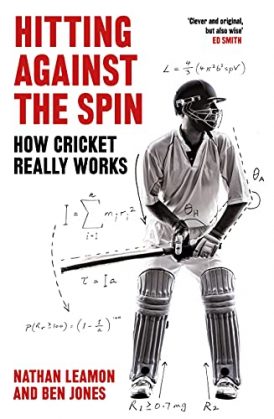Hitting Against The Spin: How Cricket Really Works
Martin Chandler |Published: 2021
Pages: 388
Author: Leamon, N and Jones, B
Publisher: Constable
Rating: 4 stars

Every now and again a new book slips under my radar and, very occasionally, that is because I have allowed it do so. This acclaimed title is one such and only now has curiosity got the better of me and persuaded me to pick up a copy.
Why is this? The answer is simple enough. At heart I am a traditionalist, and like my books to fall into predictable genres, such as biographies, autobiographies, tour books and history books. Seeing the title of this one, coupled with the appearance on the front cover of scribbled mathematical formulae, I immediately realised its content would probably be outside of my comfort zone.
I also knew that both authors were heavily invested in statistics and analysis. Never forgetting the fearsome struggle I had as a teenager to pass ‘O’ Level physics I have always tended to steer clear of anything scientific, and that was another factor that put me off.
But then it was cold out last week so, rather than take my usual brisk walk at lunchtime, I ducked into a bookshop near my office to get back in the warm. The only cricket book they had that I didn’t already own was this one, so that meant it was the one I picked up. Eoin Morgan’s foreword confirmed my expectations about the content, but also convinced me that I would like to read on, so the decision to invest was made.
I was immediately struck by the fact that, to their credit, Leamon and Jones clearly appreciate that there will be many like me, and their introduction is very well crafted. They begin with a couple of salutary tales, the Taoist monks and their tethering of cars, and a GK Chesterton homily about fences and, at a stroke, I began to understand where they were coming from.
Some of the content that follows is pretty technical, and there were a few passages I struggled with, but that says more about me than about the way the book is written. An example looks at the importance, or not, of bowlers maintaining a good length as opposed to a full length. The ability that the authors now have to record every detail of every delivery makes this sort of examination possible. It has come far too late to have any impact on the way I play the game of course, but it will alter the way I watch it and, more importantly, the judgments I come to about what I see.
One test of how well written any book on this sort of subject is how it goes about attempting to explain the mysteries of swing bowling and, more particularly, reverse swing. For those of us old enough to recall when Pakistan’s seamers were branded as cheats Leamon and Jones explain succinctly why they were anything but.
Not everything is about the game’s techniques however. For those brought up with the mantra that when a captain wins the toss he should either decide to bat immediately, or alternatively think about inserting and having done so then choose to bat, that is another part of the game that is deconstructed and then put back together again after the changing trends over time have been examined.
Also absorbing is an examination as to why there are a disproportionate number of left handed batsmen at Test level in some countries. In addition the numbers that accompany the chapter on the apparent bias of most home umpiring decisions before the introduction of neutral officials are illuminating, if not surprising, as are the conclusions about DRS.
Of all the chapters in Part I of Hitting Against The Spin: How Cricket Really Works the most interesting, even to a dinosaur like me, was the closing one which, by looking at England’s disasters against the spin attacks of Sri Lanka and Pakistan in the early months of 2012, analyse just how they managed to turn that round and, against all expectations, win in India as that same year drew to a close.
And then there is Part 2, which moves on from the red ball game to white ball and, more specifically, T20. As the years have passed I have become increasingly tolerant of cricket’s shortest format and, on occasion, have even been known to go out of my way to watch it, but I have to confess to not having read Part 2 at all yet, so I had better not comment any further on that.
As far as Part 1 of the book is concerned however I have no hesitation in declaring that my initial misgivings on the subject of Hitting Against The Spin: How Cricket Really Works were entirely misconceived, and I have little doubt but that Part 2, which comprises around a third of the book’s bulk, will be just as fascinating to those who enjoy the T20 game. This one is certainly recommended.






Leave a comment